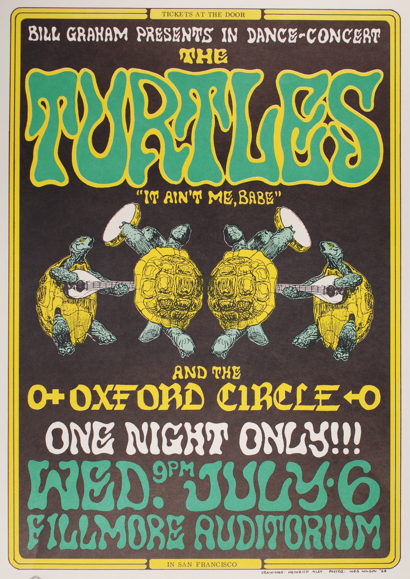The Fillmore Auditorium has been a centerpiece of San Francisco music and culture for decades. The historic music venue sits on the corner of Fillmore Street and Geary Boulevard and is known for the stellar countercultural music acts it hosted during the 1960s, including The Grateful Dead, Jefferson Airplane, Janis Joplin, Pink Floyd, The Doors and many others.

Bill Graham was the impresario responsible for booking bands for the venue for many years, and for establishing the “Fillmore Sound.” The auditorium became the epicenter for psychedelic music and counterculture which corresponded with the social phenomenon “Summer of Love.” Graham was also responsible for commissioning local artists to create posters advertising the concerts held at the venue. Among these artists were Rick Griffin and Wes Wilson, whose posters featured colorful and distorted images and text, a style iconicized in 1960s culture.
In other cases, artwork was repurposed from other sources for the posters, as was the case for the work of a German artist named Heinrich Kley. Kley was an illustrator and painter born in Germany in 1863, and was a favorite artist of Walt Disney’s. His work is currently on exhibit in the Theater Gallery of The Walt Disney Family Museum.
Kley’s illustrations were featured on a number of posters and handbills for the Fillmore Auditorium and the Matrix, a club also located in the Fillmore District. Kley’s work can be found on posters advertising performances by such 1960s bands as Big Brother and the Holding Company, the Turtles, the Grateful Dead, the Wildflower, and Moby Grape.
The artwork of Heinrich Kley was an insteresting choice to be featured as the imagery for the 1960s music scene. Though his work heralded from an earlier generation, the elements of wit and fantasy evident in his illustrations make for a fascinating addition to 1960s styling of the ads. Just as the style of the music and the spirit of the Fillmore sought to challenge the accepted cultural precepts of the era, Kley’s work had similarly gone against the grain of societal values of his own time. His artwork often confronted human imperfections and glorified folksy and even disturbing subject matter, starkly contrasting the values of German society in the first decades of the Twentieth Century. The German ruling class, which came to power following the First World War and leading to the Second, highly regarded the ideals of classicism, human strength, and cultural might. Kley’s work challenged these values.
In the 1990s, the Kley posters were sold to music merchandiser Wolfgang’s Vault, a company dedicated to collecting and archiving music recordings and memorabilia. The company was named for Fillmore impresario Bill Graham (whose given name was “Wolfgang”), and prints of vintage poster art, including the Kley illustrations, can be ordered through the company’s site.
Discovering this unexpected and interesting tie between the Walt Disney Family Museum and our San Francisco community, between several key people who never actually met, (i.e. Walt Disney, Heinrich Kley, and Bill Graham), reminds me of how relevant the collection and the story of our useum still are today. We continue to find and ascertain connections between the legacy of Walt Disney and the greater communities of art, entertainment, and culture. The opportunities to learn and be inspired are endless, and allow us the keep exploring in many different directions.

Alyssa Carnahan
Museum Educator
at The Walt Disney Family Museum
